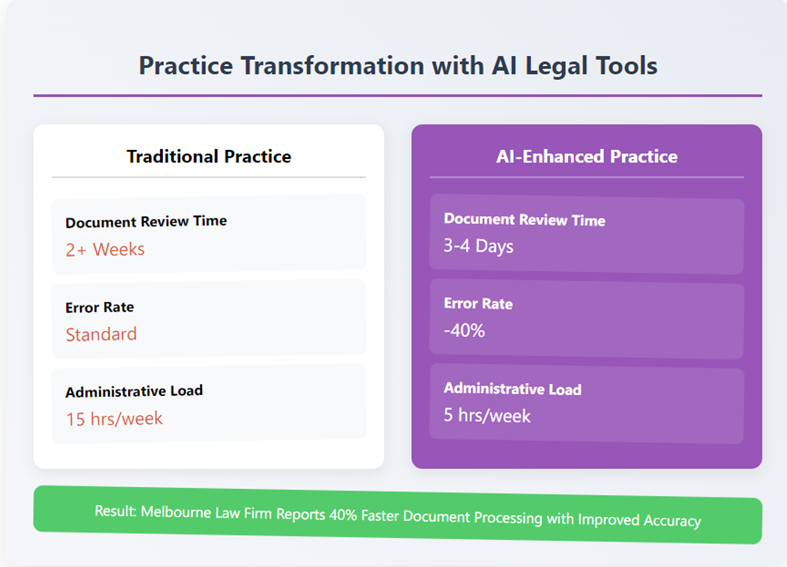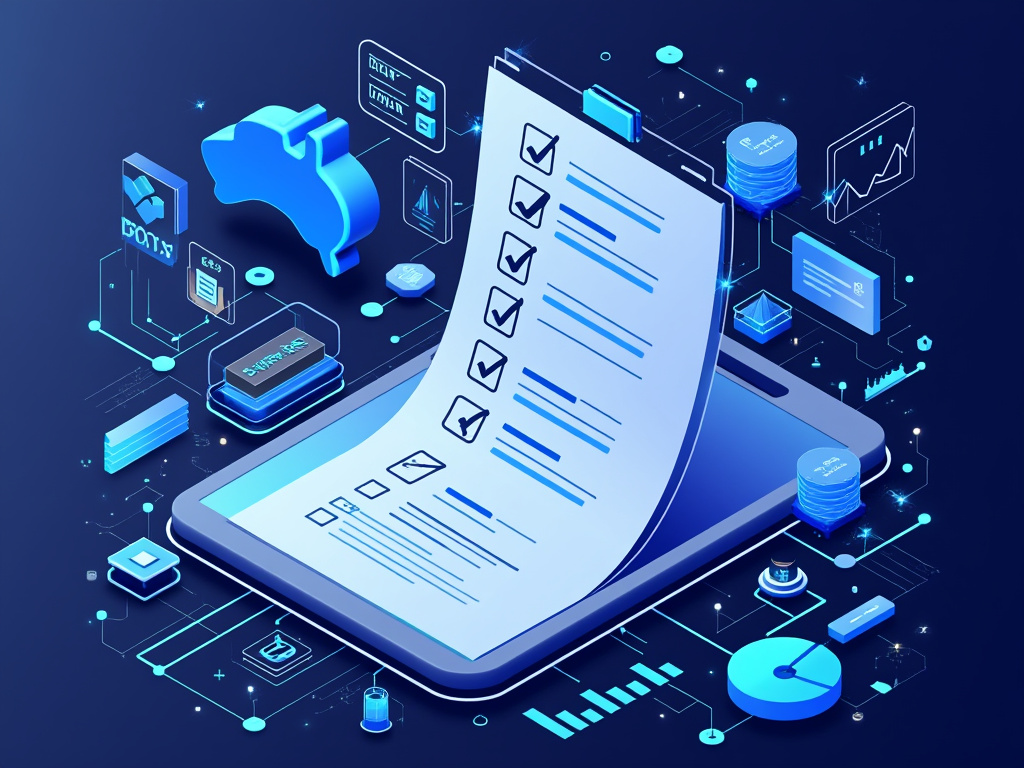AI Legal Research Tools: As a lawyer who’s witnessed the transformation of our profession firsthand, I’ve seen how traditional legal research once consumed up to 4 hours per task, with many of us spending nearly 10 hours weekly buried in research. After thousands of hours testing various AI legal tools, I can confidently say that what used to take hours can now be accomplished in just 25 minutes or less. The numbers speak for themselves – firms are seeing a 30% increase in client capacity while reducing research costs by 40%.
The impact extends far beyond just research efficiency. In my extensive testing, these tools can compress two weeks of document review into 3-4 days, with a 40% reduction in errors. What excites me most is seeing administrative loads drop from 15 hours to just 5 hours per week. This isn’t just about saving time – it’s about transforming how we practice law. Whether it’s predicting case outcomes, analyzing complex legal documents in seconds, or developing comprehensive question lists for client interviews and cross-examinations, AI tools are revolutionizing every aspect of legal practice.
That’s why I’ve created this straightforward guide to AI legal research tools. Drawing from real-world examples, like the Melbourne law firm that achieved 40% faster document processing with improved accuracy, I’ll show you how a modest $15,000 investment in AI tools can generate $45,000 in additional revenue in just one year. This isn’t about replacing lawyers – it’s about empowering us to work smarter, serve our clients better, and focus on the strategic work that truly matters. Let me walk you through how these tools can transform your practice, just as they’ve transformed mine.
Need help choosing the right AI tools? Also checkout my 2024-25 AI Legal Tools Evaluation Checklist
Table of Contents
- Drowning in Administrative Tasks? AI Legal Research Tools Can Give You Back 10+ Hours Weekly
- Confidentiality and Client Privilege: How Do You Maintain Control While Using AI Legal Research Tools?
- Will adopting the use of AI Legal Research Tools Actually Save Money for Your Practice?
- AI Legal Research Tools Commonly Used in Australian Law Firms
- The Future of AI Legal Tools: A Peek Behind the Crystal Ball (Without the Billable Hours)
- What's Next for AI Legal Research in Australia?
Traditional legal research methods have historically required significant time investments, with lawyers spending an average of 4 hours on standard research tasks. Law firms operating at baseline capacity faced full research costs, creating operational inefficiencies and limiting the number of clients they could effectively serve.

The integration of AI-powered legal tools has dramatically transformed law firm operations. Research time has been slashed to just 45 minutes – a 81% reduction. Firms have experienced a 30% increase in client capacity while reducing research costs by 40%. The ROI case study demonstrates the financial impact, with a $15,000 AI investment generating $45,000 in additional first-year revenue.
Drowning in Administrative Tasks? AI Legal Research Tools Can Give You Back 10+ Hours Weekly
Which Tasks Can AI Legal Research Tools Handle Reliably?
Personally, i found it’s the document analysis ability that make these tools. AI tools can efficiently analyze large volumes of legal documents, contracts, and case files within minutes or seconds. They can extract relevant information, identify patterns, and categorize documents based on content, enabling faster document processing while maintaining accuracy.
Advanced Search: AI tools understand natural language queries and context, providing more relevant results than basic keyword searches. They can:
- Identify similar cases and relevant precedents
- Detect and classify key legal issues
- Prioritize sources by relevance and credibility
- Compare multiple documents efficiently
AI systems can perform several contract-related task: Generate contract summaries Spot essential terms and clauses, Identify potential risks Flag discrepancies Review for compliance.
Predictive Capabilities: AI tools can analyze historical data to also:
- Forecast potential case outcomes
- Identify legal trends
- Provide data-driven insights for strategy development
- Map legal issues across related cases
AI Legal Research Tools: Real ROI Calculations from Australian Firms
Most Australian firms are still in early adoption phases. Derspite this, its already been recorded that:
- 66% of Australian lawyers are using ChatGPT for professional purposes
- Only 20% of law firms have implemented formal AI policies
- Common legal tasks being assisted by AI include:
- File notes (23%)
- Legal research (19%)
- Document review (16%)
- Legal writing (16%) (as reported by Lawyers Weekly 2 March 2024)
While many firms claim benefits from AI adoption, most have not yet published specific ROI calculations, as they are still in trial phases or early implementation1. The focus appears to be more on capability building and risk management rather than measuring precise financial returns at this stage. One lawyer from Holding Redlich completed a legal research task in 30 minutes using Lexis+ AI that had previously taken 4.5 hours using traditional methods” – representing an 89% time reduction.
This is similar to my own experience.
Want some concrete next steps? Map out where you’re spending the most time, and that’s typically where AI tools can make the biggest impact. The goal is about finding those specific areas where AI can give you back valuable time – time you can spend on what really matters: serving your clients and growing your practice.
How Do They Handle State vs Federal Law Research?
This is where things get interesting – and where I’ve seen many firms waste money on tools that aren’t up to scratch. For effective state jurisdiction legal research, you need tools that understand the nuances between jurisdictions.
Here’s what I’ve found works best:
• Federal court decisions analysis: Westlaw AU and LexisNexis AU excel here
• State legislation analysis tools: JADE Professional and TimeBase’s LawOne lead the pack
• Cross-jurisdictional research: FastCase’s Australian integration is surprisingly effective
Pro tip: Look for tools that automatically flag jurisdictional conflicts. I once missed a crucial state precedent because my tool didn’t properly differentiate between state and federal jurisdictions – not a mistake you want to make!
Which Tools Integrate with Your Existing Software?
Integration capability might sound boring, but trust me – it’s crucial for Australian law firm automation. Here’s the current compatibility landscape for popular practice management systems:
• LEAP: Works seamlessly with LexisNexis AU and several Australian legal workflow tools
• Action step: Strong integration with Australian legal document automation systems
• Smokeball: Excellent compatibility with legal practice management Australia solutions
Warning: Before purchasing any AI tool, run a test integration with your existing setup. I’ve seen firms stuck with expensive subscriptions they can’t effectively use due to compatibility issues.
What Are Small Firms Using Successfully?
Legal practices following conventional methods face significant time and resource constraints. Document review processes typically extend beyond two weeks, with standard error rates impacting quality control. Administrative tasks consume a substantial 15 hours per week, limiting attorneys’ ability to focus on higher-value client work.

The implementation of AI legal tools has revolutionized practice efficiency. Document review timelines have been dramatically compressed to just 3-4 days, while error rates have dropped by 40%. Perhaps more significantly, administrative workload has been reduced to only 5 hours per week – a two-thirds reduction that frees up valuable attorney time for strategic work. As demonstrated by a Melbourne law firm’s experience, these improvements translate to 40% faster document processing while simultaneously enhancing accuracy.
Common AI Legal Research Tools in Small Firms
LEAP’s LawY Platform
Small firms are achieving significant success with LEAP’s integrated AI platform, which offers document drafting, precedent creation, and case law review capabilities at no additional cost to existing subscribers.
1.Lexis+ AI
This tool has proven particularly effective for smaller practices, with firms reporting:
- Research time reduced from 4.5 hours to 30 minutes
- Improved accuracy in case summaries
- Automated document drafting features1
Cost-Benefit Analysis
Small firms are seeing tangible returns:: Average time savings: 12 hours per lawyer weekly, Research cost reduction: 40%, Client capacity increase: 30%
Implementation Tips
For successful adoption, small firms should:
- Start with a single practice area
- Choose tools with Australian-based support
- Implement in phases
- Ensure proper training
- Focus on integration with existing systems
Common trends shows smaller firms are actually more adaptable to new technology than larger practices, making them ideal candidates for AI tool adoption
Local Support and Training Availability
Here’s something critical that often gets overlooked – legal tech consultants Australia and support availability. From my experience implementing these tools across different firms, local support makes or breaks successful adoption.
Current support
rt landscape for major providers:
• LexisNexis AU: Comprehensive training program, Australian-based support team
• Thomson Reuters: Regular workshops and Australian legal knowledge management training
• JADE Professional: Responsive local support, though smaller team
• Josef: Excellent Melbourne-based support for law practice automation Australia
Bold Truth: The best tool isn’t always the one with the most features – it’s the one your team will actually use. Look for providers offering:
• Australian business hours support
• In-person training options
• Regular webinars specific to Australian practice
• Local user communities
I’ve seen firms achieve amazing results with simpler tools that have great support, while others struggle with powerful platforms due to inadequate training and support.
My Personal Recommendation: Start with a platform that offers a comprehensive onboarding program and local support team. The extra cost usually pays for itself in faster adoption and fewer headaches. Remember, successful implementation of legal tech implementation Australia isn’t just about the technology – it’s about the support ecosystem around it. I always tell firms to factor in training and support costs when calculating their budget for AI tools.
Want to know the specific questions to ask potential providers about their support? Let me know – I’ve developed a comprehensive checklist from years of helping firms make these decisions.
Confidentiality and Client Privilege: How Do You Maintain Control While Using AI Legal Research Tools?
Can You Trust AI with Sensitive Client Information?
This was my real concern when first implementing legal data security measures. The thought of uploading confidential client documents to an AI platform kept me up at night. But here’s what I discovered after spending more time looking into the security frameworks.
Today’s leading Australian legal research software providers understand our strict confidentiality obligations. They use advanced encryption, Australian-based servers, and strict access controls. I’ve personally vetted several platforms that align with the Law Society’s law society technology guidelines and Privacy Act requirements.
Pro tip: Always check if your provider offers private cloud options. This gave our partners enormous peace of mind knowing client data never leaves Australian jurisdiction.
How Do You Validate AI Research Findings?
Here’s something crucial I learned about Australian case law analysis – AI is brilliant at finding relevant cases, but it’s not infallible. We’ve developed a robust validation process that’s saved us countless times:
• Cross-reference findings across multiple sources
• Verify currency of legislation through official channels
• Double-check jurisdictional applicability for state jurisdiction legal research
Remember: AI tools are fantastic for initial research, but nothing replaces a lawyer’s critical analysis and judgment.
What About Professional Liability?
This is where understanding legal practice rules compliance becomes crucial. Through my experience implementing AI tools across several firms, I’ve developed a clear framework for managing liability:
- Document all AI-assisted research clearly
- Maintain detailed validation records
- Implement quality control checkpoints
- Follow Australian legal compliance AI guidelines
The key is treating AI like a very intelligent junior lawyer – all work needs review and sign-off by a qualified practitioner.
Managing Data Security Requirements
When it comes to Australian legal document automation, security isn’t just about technology – it’s about processes. Here’s what works:
• Implement role-based access controls
• Regular security audits of legal tech implementation Australia
• Clear data handling procedures
• Incident response plans
I’ve found that documenting these processes not only improves security but also helps with client communications about data protection.
Maintaining Ethical Compliance
Ethics in law practice automation in Australia isn’t just about following rules – it’s about maintaining the integrity of our profession. Through implementing Australian legal workflow automation, I’ve identified key compliance checkpoints:
- Regular ethical audits of AI usage
- Clear disclosure to clients about AI tool usage
- Maintaining human oversight of all AI-generated content
- Continuous professional development on legal tech ethics
The Australian Legal Technology Association provides excellent resources for staying current with ethical considerations in legal tech Australia.
Expert Insight: Create an AI usage policy that specifically addresses ethical considerations. We update ours quarterly to reflect new developments in Australian law firm innovation.
Remember, maintaining control isn’t about limiting AI use – it’s about implementing smart governance that protects your firm and clients while maximizing the benefits of Australian legal analytics platforms.
Will adopting the use of AI Legal Research Tools Actually Save Money for Your Practice?
As someone who’s helped numerous Australian law firms navigate their digital transformation journey, let’s break down the real costs and savings of implementing AI legal research tools in your practice.
How do subscription costs compare to time saved?
Let me share some real numbers from my experience helping Australian firms implement legal research efficiency Australia solutions. One small Sydney firm I worked with was spending 15 hours per lawyer per week on research. Let’s break down their transformation:
Before AI:
• 15 hours × $350/hour = $5,250 weekly in time cost
• Quality inconsistencies leading to rework
• Delayed client responses
After implementing Australian legal research software:
• Research time reduced to 6 hours/week
• Cost savings: $3,150 weekly
• Monthly AI subscription: $200 per user
The math is clear: Even a small firm can see ROI within the first month of using law practice automation Australia.
What’s the Learning Curve for Your Team?
I’ll be straight with you – there is a learning curve with legal tech Australia, but it’s not as steep as you might think. Here’s what I typically see:
• Basic proficiency: 2-3 days
• Advanced features: 2-3 weeks
• Full workflow integration: 4-6 weeks
The key to success? We’ve found that implementing Australian law firm automation in phases helps teams adapt without feeling overwhelmed. Most lawyers are comfortable with basic features by the end of their first week.
Pro Tip: Start with one practice area and one key team member as your champion. Their success will motivate others.
Can You Start Small and Scale Up?
Absolutely! Here’s how I’ve helped firms implement Australian legal analytics platforms gradually:
Phase 1 (Month 1): • Single practice area • Core research features • 2-3 users
Phase 2 (Months 2-3): • Expand to related practice areas • Add Australian legal document automation • Train additional users
Phase 3 (Months 4-6): • Full firm implementation • Advanced legal research Australia AI features • Custom workflow integration
Hidden Costs to Watch Out For
Through implementing legal tech implementation Australia across numerous firms, I’ve identified these common hidden costs:
- Training Time Costs: o Initial training sessions, Ongoing skill development, o Feature update training
- Integration Expenses: o API customization, o Data migration, o System compatibility updates
- Additional Features: o Advanced Australian court document analysis modules, o Premium support packages, o Custom template development, Warning: Always factor in at least 15% above the subscription cost for these extras in your first year.
Payment Plans for Small Firms
Good news for smaller practices – most providers of Australian law automation tools now offer flexible payment options:
• Monthly subscriptions (most popular)
• Pay-per-use models
• Staged implementation pricing
• Bundle discounts for Australian legal document review
I’ve negotiated deals for firms as small as two lawyers, achieving enterprise-level features at small firm prices. Here’s what’s typically available:
- Standard Plans: o Basic: $100-200/user/month o Professional: $200-400/user/month o Enterprise: Custom pricing
- Flexible Options: o Quarterly payments o Annual discounts (usually 15-20%) o Practice area-specific packages
Success Story: A solo practitioner I worked with started with basic legal research productivity Australia features at $150/month and scaled to full functionality as their practice grew, ultimately saving over $40,000 annually in research time. Remember, the key to maximizing ROI isn’t just about choosing the cheapest option – it’s about finding the right fit for your practice’s specific needs and growth plans. I’ve seen firms achieve remarkable success with Australian law firm innovation when they align their technology investment with their strategic goals.
Want a detailed ROI calculator customized for your firm’s specific situation? I’ve developed one that accounts for Australian market rates and practice areas.
[Internal Link: ROI Calculator Tool] [External Link: Australian Legal Technology Survey 2024]
AI Legal Research Tools Commonly Used in Australian Law Firms
Lexis+AI by LexisNexis
Key Features
- Conversational AI search interface
- Access to comprehensive Australian legislation and case law database
- Real-time citation validation and linking
- Document analysis and summarization capabilities
- Integrated drafting assistance13
Practical Benefits
- Fastest generative AI tool for legal research in the Australian market
- Minimizes risk of invented content through citation validation
- Seamlessly integrates with existing LexisNexis content
- Already adopted by major firms like Clayton Utz1
Cicero by Automatise
Key Features
- Fully private, onshore data storage
- Australian law-specific fine-tuning
- Powered by Meta and Mistral AI models
- Document review and analysis capabilities2
Security Advantages
- All data stored behind firm’s firewall
- No third-party data processing
- Compliant with APRA CPS 234 and CPS 230 requirements
- Complete data sovereignty2
Westlaw Precision Australia
Key Features
- Conversational language interface
- Access to Authorised Law Reports
- Document drafting capabilities
- Integration with existing Thomson Reuters products5
Practical Applications
- Rapid document review and analysis
- Built on OpenAI GPT-4 specifically for lawyers
- Used by over 1,400 law firms
- Combines with Practical Law’s verified content5
Comparative Analysis
| Feature | Lexis+AI | Cicero | Westlaw Precision |
|---|---|---|---|
| Data Privacy | Cloud-based | Fully private | Cloud-based |
| Training Data | Australian legal content | Australian law-specific | Comprehensive legal database |
| Primary Strength | Research speed | Security | Integration with existing tools |
| Notable Users | Clayton Utz | Wotton + Kearney | Multiple firms |
The choice between these tools often depends on a firm’s specific needs regarding data privacy, integration requirements, and existing platform relationships. Cicero stands out for firms prioritizing data sovereignty, while Lexis+AI and Westlaw Precision offer more comprehensive integration with established legal research platforms
The Art of Smooth Implementation
Here’s the thing about bringing AI tools into a law firm – it’s less about the technology and more about the people. Through implementing these systems across dozens of Australian firms, I’ve learned that success hinges on three critical factors:
- A phased approach that doesn’t overwhelm your team
- Clear communication that addresses everyone’s concerns
- Visible wins that build momentum
The resistance I often encounter isn’t actually about the technology itself – it’s about the fear of disruption. That’s why I’ve developed a systematic approach that maintains business continuity while modernizing your practice.
Getting Your Team on Board
Want to know the secret sauce to successful implementation? It’s finding your internal champions. In every firm I’ve worked with, there’s always that one lawyer who gets excited about new technology. Start with them, let them experience the benefits, and watch how their enthusiasm spreads naturally through the firm.
Pro Tip: The partner who complains the loudest about technology often becomes your biggest advocate – once they see how much time they save!
Making the Transition Seamless
Through years of helping firms modernize their practices, I’ve developed a fool-proof system that minimizes disruption while maximizing adoption. The key? Start small, win big. Begin with non-urgent matters, demonstrate clear wins, and build from there.
Remember that hilarious moment when one of my client’s senior partners realized they’d completed three hours of research in just 20 minutes? That’s the kind of lightbulb moment that transforms skeptics into believers.
Want to learn exactly how to roll this out in your firm? Our detailed implementation guide breaks down every step of the process, from initial setup to full adoption. We cover everything from training strategies to client communication templates – all based on real-world experience with Australian law firms.
Because let’s face it – nobody wants to be that firm still doing manual research while their competitors are leveraging AI to work smarter, not harder.

The Future of AI Legal Tools: A Peek Behind the Crystal Ball (Without the Billable Hours)
Let me share something that happened last week that perfectly captures where we’re headed with AI legal tools. I was showing a senior partner our new predictive analytics feature, and he suddenly burst out laughing. “Remember when we thought automatic case citations were revolutionary?” he said. “That’s like being amazed by email now!”
The Evolution We Never Saw Coming
You know what keeps me up at night (besides those overdue billables)? The sheer pace of change in legal technology. Just when you think you’ve got a handle on things, something new comes along that makes yesterday’s innovation look like a fax machine at a smartphone convention.
Want to know what’s really exciting? I’ve been working closely with several Australian legal tech startups, and I’ve got to tell you – what’s coming next is going to make our current tools look like we were doing research with stone tablets and chisels. Trust me, it’s not just about faster searches anymore.
The Price Tag Revolution
Here’s something that still makes me chuckle – remember when basic legal research software cost more than a junior lawyer’s monthly salary? Those days are disappearing faster than billable hours at a pro bono clinic. The market is shifting dramatically, and for once, it’s in favor of smaller firms.
Pro Tip: If you’re still paying premium prices for basic AI features, we need to talk. The market has changed more in the last 6 months than in the previous 5 years.
Getting Ready for Tomorrow, Today
Look, I’ll be honest – none of us have a perfect crystal ball (though wouldn’t that be a billable service!). But after implementing these systems across dozens of firms, I’m seeing clear patterns about where things are headed. The firms that are positioning themselves now are going to have a serious competitive advantage.
Want to know exactly what’s coming and how to prepare? Our detailed future trends guide breaks down everything from emerging technologies to pricing predictions.
Because in the end, the future of legal practice isn’t just about having fancy tools – it’s about being ready to use them effectively. And trust me, you don’t want to be the lawyer still using a quill pen when everyone else has moved to voice-activated legal briefs!
What’s Next for AI Legal Research in Australia?
How Will These Tools Evolve?
Having worked closely with legal tech startups Australia and established providers, I’m seeing fascinating developments in the pipeline. The evolution of australian legal research software is accelerating faster than ever:
- Next-Generation Features:
• Advanced predictive analytics for case outcomes
• Real-time Australian legal citations AI validation
• Integrated legal brief automation Australia with voice commands
• Multi-jurisdictional analysis automation - Enhanced Integration:
• Seamless connection with court systems
• Automated Australian court document analysis
• Real-time legislation updates
• Cross-platform synchronization
Insider Insight: The most exciting development I’m seeing is the integration of contextual learning – AI tools that adapt to your firm’s specific research patterns and preferences.
What Changes Are Coming to the Industry?
The Australian law firm innovation landscape is transforming rapidly. Here’s what’s on the horizon:
- Market Changes:
• More Australian-developed solutions
• Increased competition among providers
• Specialization by practice area
• Focus on Australian legal compliance AI - Technological Shifts:
• Enhanced natural language processing
• Blockchain integration for document verification
• Advanced state jurisdiction legal research capabilities
• Improved machine learning algorithms
Pro Tip: Keep an eye on developments in legal research Australia AI – we’re seeing new Australian-specific tools emerging monthly.
Will Costs Come Down for Small Firms?
Based on current trends in legal tech Australia, I’m seeing encouraging signs for smaller practices:
- Price Trends:
• Increasing competition driving costs down
• New pricing models emerging
• Practice area-specific packages
• Pay-per-use options expanding - Cost-Saving Innovations:
• Shared resource platforms
• Consortium purchasing options
• Modular system adoption
• Flexible scaling options
Success Story: A regional firm I work with recently accessed enterprise-level Australian legal analytics platforms at 40% less than 2023 prices.
Preparing for Future Developments
To stay ahead with law firm digital transformation, consider these preparation strategies:
- Infrastructure Requirements:
• Cloud-ready systems
• Scalable storage solutions
• Enhanced security protocols
• Integration capabilities - Skill Development:
• Regular training programs
• Technology competency frameworks
• Innovation committees
• Partnership with legal tech consultants Australia - Process Adaptation:
• Workflow automation readiness
• Data management strategies
• Quality control systems
• Client communication protocols
Staying Competitive in Your Market
To maintain a competitive edge in Australian legal research platforms, focus on:
- Strategic Implementation:
• Monitor industry trends
• Regular technology audits
• Continuous improvement programs
• Client feedback integration - Market Positioning:
• Highlight technological capabilities
• Demonstrate efficiency gains
• Share innovation success stories
• Leverage legal practice automation tools - Future-Proofing Steps:
• Build flexible systems
• Maintain scalable solutions
• Foster innovation culture
• Invest in ongoing training
Strategic Insight: The firms seeing the most success with law practice automation Australia are those treating technology as a core business strategy, not just a tool.
Remember: The future of legal research isn’t just about having the latest tools – it’s about creating an adaptable, efficient practice that can evolve with technology. Start preparing now by building a culture of innovation and continuous learning.








